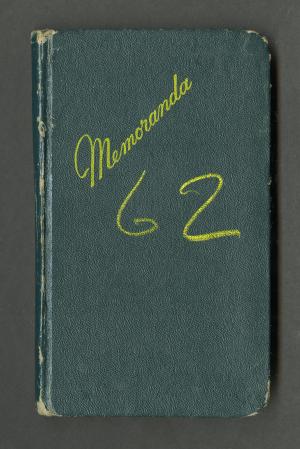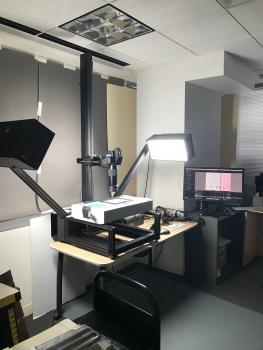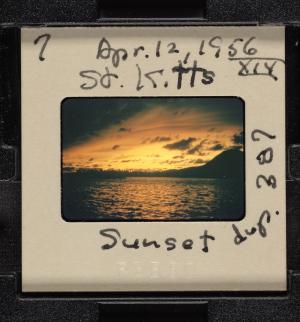What is a field book and how do you digitize one? These were the first two questions I asked when I came on board at the Archives as the Summer 2018 Field Book Project Digitization Intern. During the course of my internship, I discovered the answer to both questions and learned a lot about digitization practices and standards at the Smithsonian.

According to the Biodiversity Heritage Library, “Field books, also called field notes or field documentation, are original records of scientific discovery. They are primary source documents that describe the events leading up to and including the collection of specimens or observations during field research.” Though field books share a common purpose - recording scientific discovering at the sight of investigation - they vary greatly in content and format. Some of the formats I came across while digitizing this summer include: transparencies, such as slides and stereo slides, negatives (some of which are glass plate), photographs, prints, diaries, notebooks, spreadsheets, maps, pamphlets, letters, and charts.
Because the field books are so diverse in format, different digitization equipment must be used for differing formats to ensure the best image quality. The options available at the Archives include a flatbed scanner, a book scanner, and a professional grade camera on a copy stand setup. When deciding which digitization equipment to use, there are four things I consider: the size of the item, image quality, the compatibility with each digitization equipment, and efficiency.
 Size
Size
The size of an item is important to pay attention to because each digitization equipment has different capabilities in what it can accommodate, and the overall output quality produced. The flatbed scanner can accommodate anything under 12.2” X 17.2” and is a great option for small or medium sized loose-leaf items such as small manuscripts, photographs, index cards, or anything under 10 inches on the longest side. Conversely, oversized materials such as maps, spreadsheets, or other large items are best suited for overhead camera digitization on a copy stand setup. Overhead camera digitization is an ideal method of digitization because the height of the camera and the lens can capture a wider field of view. The book scanner is great for medium sized loose-leaf or bound material.

Image quality
The minimum resolution requirement at the Smithsonian Institution Archives is 6000 pixels on the longest side of the image, scanned at a minimum of 600 pixels per inch (ppi). A small item under 10 inches on the longest side will need to be scanned at a higher ppi to achieve a minimum of 6000 pixels on the longest side. The flatbed scanner can reach a resolution of up to 2400 ppi, which is why small items work well on it. The editing software for the camera copy stand setup can also adjust ppi during processing. The highest ppi setting on the book scanner, however, is only 600, which is why the book scanner is great for scanning items that are 10 inches and above on the longest side of the page, but smaller than 17 inches.
Compatibility
Another consideration is the compatibility of an item with the digitization equipment. For instance, negatives or transparencies such as slides and stereo slides need a light source underneath to illuminate the image. A light box can be placed underneath the camera in the copy stand setup to act as a table and a macro lens can be used to achieve a close focus on the slide, stereo slide, or negative. Although the flatbed has transparency adaptors that allow slides to be scanned, most times the frame is obscured by the slide tray that the slide sits in. The overhead camera can capture the reflective part of the slide (which usually has writing on it) as well as the film, which is why it is the preferred method.
 Efficiency
Efficiency
The Field Book Project is a massive initiative with hundreds of field books that are on target to be digitized by the end of the year. With monthly goals to meet, efficiency is key. The camera copy stand setup is the fastest digitization equipment in the office. Setup is the longest part of the process and requires skill to adjust color accuracy and focusing, but once it is ready to go it is a lot quicker from image to image. The book scanner also uses rapid capture techniques and has a bulk edit action feature that can crop, rotate, save, close, etc, with the click of a hotkey. The flatbed scanner is the easiest to use because it has built in automation and doesn’t require much skill or setup, but it can also be the slowest. With the ppi set at 600 or above, each exposure can take a minimum of 3 to 4 minutes. A folder of 30 photographs is faster on the camera copy stand setup, but two or three photographs can save a lot more time on the flatbed because of the absence of set up time.
The Field Book Project is an ongoing project that I have had the pleasure to contribute to, if only in a minor way. However, I hope my guide can serve to help other interns or participants who will continue to contribute to the efforts of creating greater accessibility for these important sources of scientific discovery to researchers.
Related Resources
- The Field Book Project, Biodiversity Heritage Library
- The Field Book Project, Smithsonian Institution Archives
- Slide Digitization Goes Stereo, The Bigger Picture, Smithsonian Institution Archives
Produced by the Smithsonian Institution Archives. For copyright questions, please see the Terms of Use.

Leave a Comment